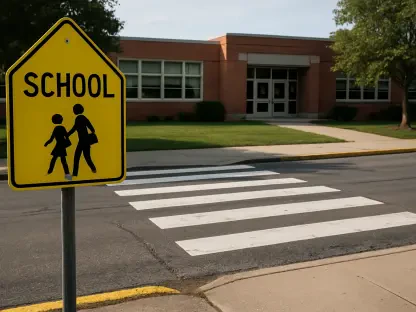The landscape of American education is currently embroiled in a heated debate over diversity, equity, and inclusion (DEI) initiatives, as federal policies clash with judicial oversight and public opinion. A recent ruling by a federal judge in Maryland has thrown a wrench into the current administration’s aggressive push to dismantle DEI practices in K-12 schools and higher education, labeling the U.S. Department of Education’s actions as unlawful. This decision not only challenges the executive branch’s approach but also raises broader questions about how far federal authority can extend in reshaping educational equity without igniting significant pushback from stakeholders. As legal battles unfold, the tension between policy enforcement and constitutional boundaries becomes increasingly evident, setting the stage for a pivotal moment in the national discourse on race-conscious practices in education. This complex scenario demands a closer examination of the events, reactions, and potential ramifications for schools and universities across the country.
Legal Challenges to Federal Directives
Judicial Pushback on Policy Overreach
The U.S. Department of Education’s recent attempts to restrict DEI initiatives have encountered a formidable obstacle in the form of a federal court ruling. Earlier this year, the department issued a directive to school districts, threatening to cut federal funding to institutions that continued race-conscious practices in areas like admissions, scholarships, and programming. This move was grounded in a broad interpretation of a Supreme Court decision that previously altered affirmative action policies in higher education. Additionally, state education leaders were required to certify compliance almost immediately to secure financial assistance, a mandate that many saw as coercive. However, a Maryland federal judge, appointed during the Trump era, declared these actions unconstitutionally vague, effectively vacating both the directive and the certification requirement. The judge underscored that while the administration has the right to express policy preferences, it must operate within the legal frameworks established by Congress and respect constitutional protections.
Implications of the Court’s Decision
This judicial intervention marks a significant setback for the administration’s broader agenda to eliminate DEI frameworks across federal sectors, particularly in education. The ruling emphasized the necessity for clarity and precision in policy directives, highlighting that vague or overly broad mandates are unlikely to withstand legal scrutiny. Educational institutions, already navigating complex equity issues, now find themselves in a precarious position, balancing federal expectations with local needs and legal obligations. The decision also sends a clear message to policymakers that unilateral actions perceived as infringing on established rights will face robust challenges. Stakeholders, including school administrators and advocacy groups, are likely to use this precedent to push back against similar initiatives, potentially reshaping how federal agencies approach policy enforcement. As this legal battle continues to unfold, it reveals the delicate balance between executive power and judicial oversight in shaping the future of educational equity.
Stakeholder Reactions and Broader Impacts
Responses from Educational Advocates
The fallout from the federal judge’s ruling has elicited a spectrum of reactions from key players in the education sector, reflecting the polarized nature of the DEI debate. The American Federation of Teachers, along with its Maryland chapter and other organizations, celebrated the decision as a vital defense of educational equity and historical accuracy. Union leaders argued that the Department of Education’s directives threatened the foundational principle of equal opportunity, risking the marginalization of already vulnerable student populations. Their stance underscores a broader concern among educators that dismantling DEI programs could undo decades of progress in addressing systemic disparities in schools and universities. This perspective positions the ruling as a safeguard against policies that might disproportionately harm minority students and limit access to inclusive educational environments, fueling a renewed commitment among advocacy groups to protect such initiatives.
Federal Resolve and Ongoing Tensions
In contrast, the U.S. Department of Education expressed disappointment with the court’s decision but reiterated its dedication to enforcing anti-discrimination protections under Title VI. Officials maintained that the ruling does not derail their overarching mission to ensure student safety and equity, suggesting a determination to find alternative pathways to align educational practices with their policy goals. This response highlights an ongoing tension between federal ambitions and legal constraints, as the administration grapples with how to advance its agenda without overstepping constitutional limits. The clash of viewpoints between the department and advocacy groups illustrates a deeper societal divide over the role of race and equity in public institutions. As this debate persists, it is evident that the struggle over DEI in education is emblematic of larger political and cultural battles, with each side firmly entrenched in its vision for the future of American schooling.
Long-Term Ramifications for Educational Policy
Looking ahead, the implications of this legal setback extend far beyond the immediate ruling, potentially influencing how federal policies on DEI are crafted and implemented in the coming years. Schools and universities may face increased uncertainty as they navigate conflicting directives and await further clarity from ongoing litigation or revised federal guidance. The judiciary’s role as a check on executive power has been reaffirmed, suggesting that future attempts to curb DEI practices will need to be meticulously grounded in legal and procedural rigor to avoid similar challenges. Moreover, this case could embolden other districts and organizations to contest federal overreach, creating a ripple effect across the educational landscape. As policymakers and educators reflect on these developments, the focus must shift toward fostering dialogue and collaboration to address equity issues in a manner that withstands legal and public scrutiny, ensuring that educational environments remain inclusive and accessible for all students.









